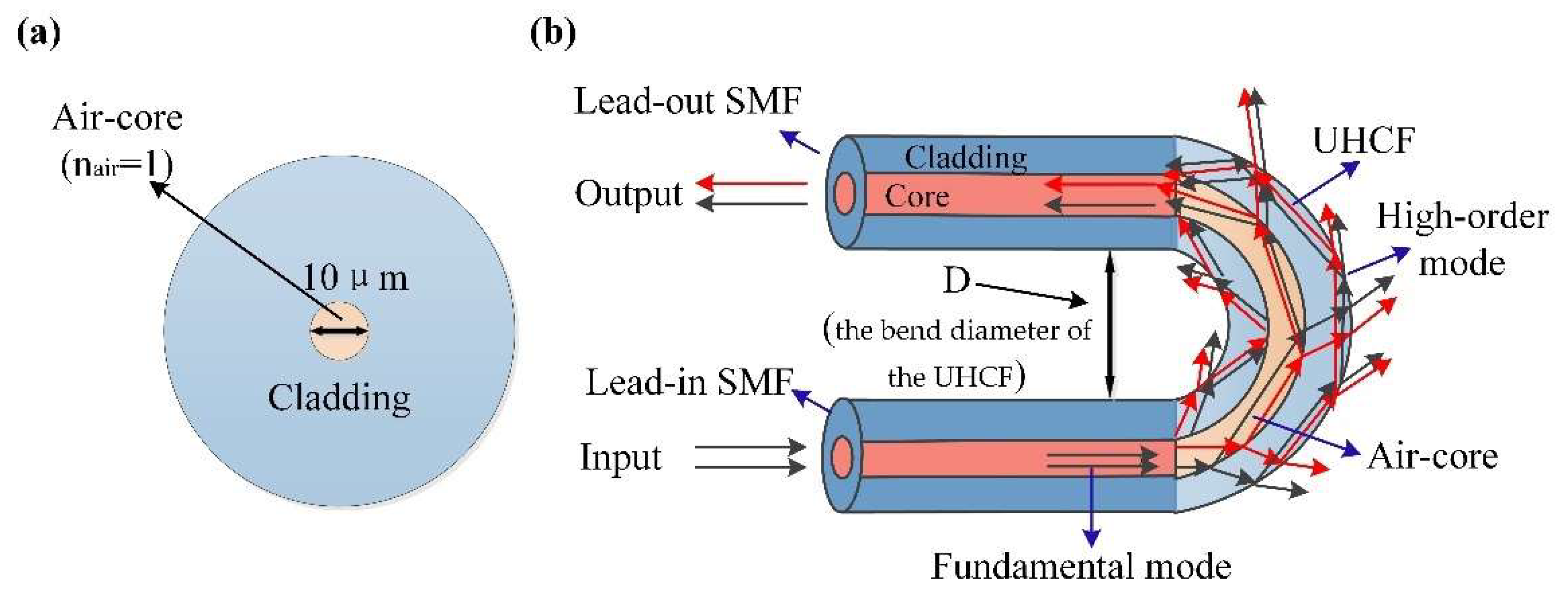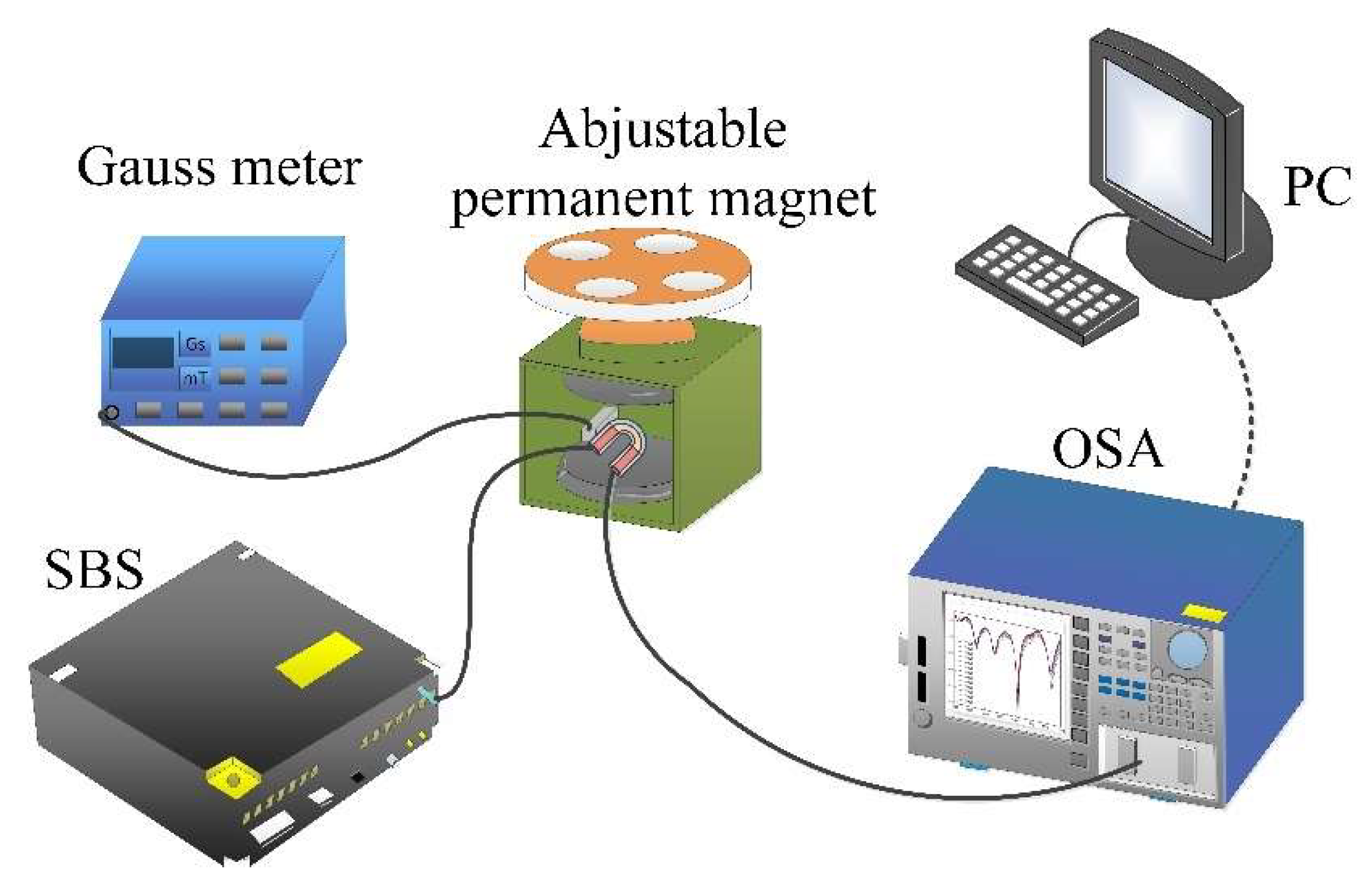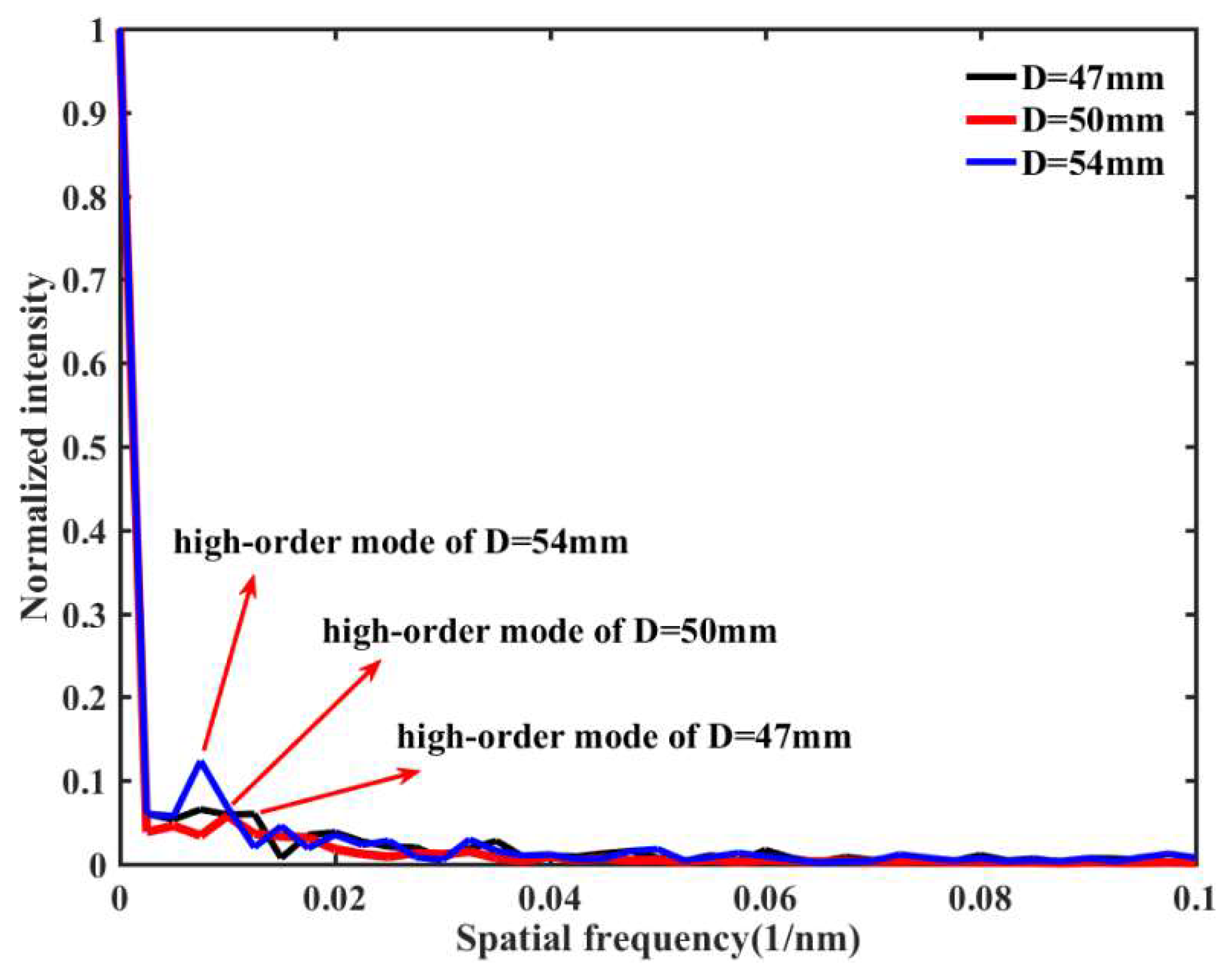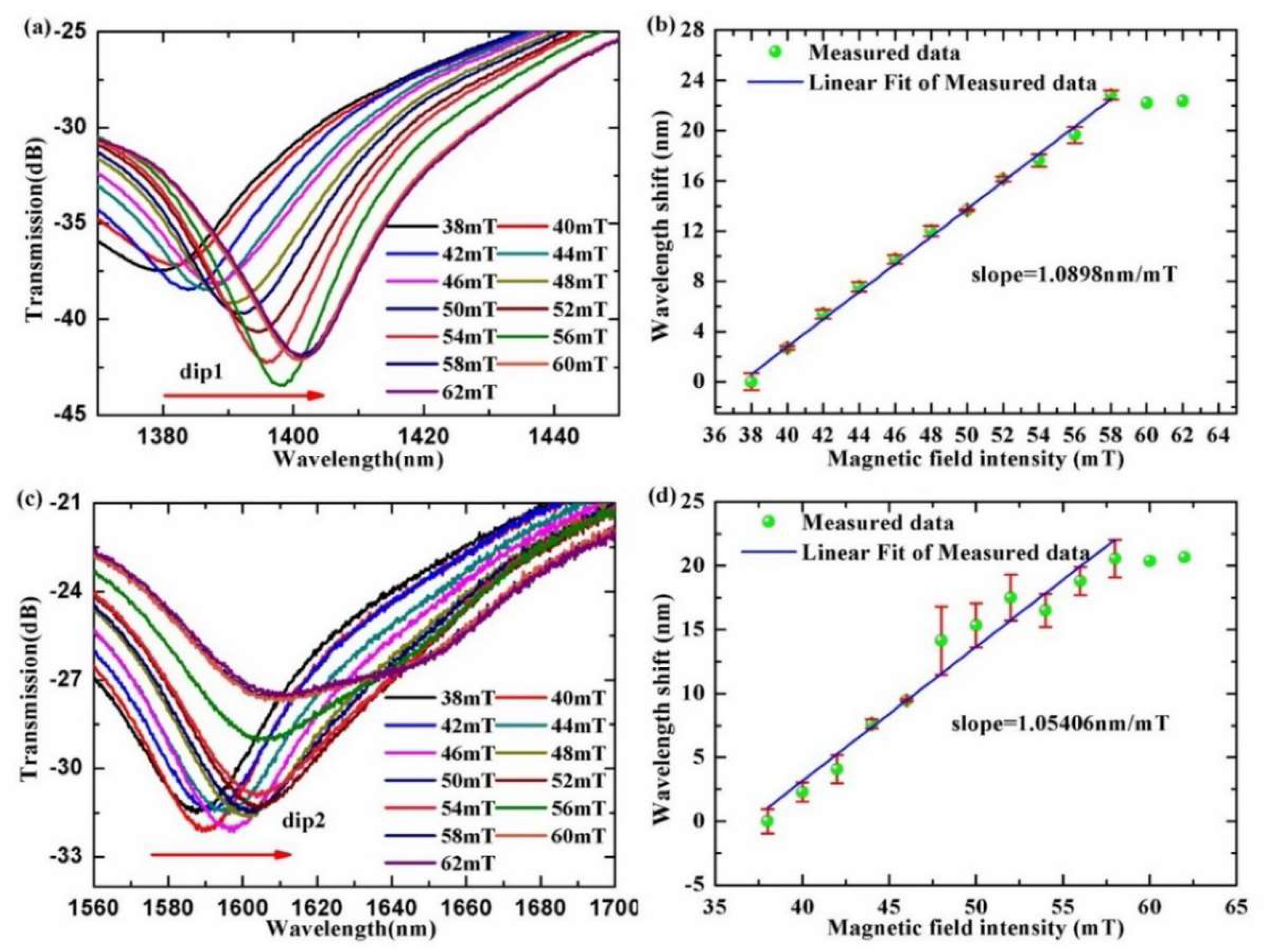Simultaneous Measurement of Magnetic Field and Temperature Utilizing Magnetofluid-Coated SMF-UHCF-SMF Fiber Structure
Abstract
:1. Introduction
2. Preparation and Principle
3. Experimental Results and Discussion
3.1. Refractive Index Measurement
3.2. Magnetic Field Intensity Measurement
3.3. Temperature Measurement
3.4. Analysis of Experimental Results
3.5. Comparison with Other Sensing Structure
4. Conclusions
Author Contributions
Funding
Institutional Review Board Statement
Informed Consent Statement
Data Availability Statement
Conflicts of Interest
References
- Heremans, J. Solid-state magnetic-field sensors and applications. J. Phys. D Appl. Phys. 1993, 26, 1149–1168. [Google Scholar] [CrossRef] [Green Version]
- Li, G.X.; Joshi, V.; White, R.L.; Wang, S.X.; Kemp, J.T.; Webb, C.; Davis, R.W.; Sun, S.H. Detection of single micron-sized magnetic bead and magnetic nanoparticles using spin valve sensors for biological applications. J. Appl. Phys. 2003, 93, 7557–7559. [Google Scholar] [CrossRef]
- Chen, L.X.; Huang, X.G.; Zhu, J.H.; Li, G.C.; Lan, S. Fiber magnetic-field sensor based on nanoparticle magnetic fluid and Fresnel reflection. Opt. Lett. 2011, 36, 2761–2763. [Google Scholar] [CrossRef] [PubMed] [Green Version]
- Herrera-May, A.L.; Soler-Balcazar, J.C.; Vazquez-Leal, H.; Martinez-Castillo, J.; Vigueras-Zuniga, M.O.; Aguilera-Cortes, L.A. Recent Advances of MEMS Resonators for Lorentz Force Based Magnetic Field Sensors: Design, Applications and Challenges. Sensors 2016, 16, 1359. [Google Scholar] [CrossRef] [PubMed] [Green Version]
- Murzin, D.; Mapps, D.J.; Levada, K.; Belyaev, V.; Omelyanchik, A.; Panina, L.; Rodionova, V. Ultrasensitive Magnetic Field Sensors for Biomedical Applications. Sensors 2020, 20, 1569. [Google Scholar] [CrossRef] [Green Version]
- Bichurin, M.; Petrov, R.; Sokolov, O.; Leontiev, V.; Kuts, V.; Kiselev, D.; Wang, Y.J. Magnetoelectric Magnetic Field Sensors: A Review. Sensors 2021, 21, 6232. [Google Scholar] [CrossRef] [PubMed]
- Reig, C.; Cubells-Beltran, M.D.; Munoz, D.R. Magnetic Field Sensors Based on Giant Magnetoresistance (GMR) Technology: Applications in Electrical Current Sensing. Sensors 2009, 9, 7919–7942. [Google Scholar] [CrossRef]
- Rashleigh, S.C. Magnetic-field sensing with a single-mode fiber. Opt. Lett. 1981, 6, 19–21. [Google Scholar] [CrossRef]
- Zhao, Y.; Wu, D.; Lv, R.Q.; Ying, Y. Tunable Characteristics and Mechanism Analysis of the Magnetic Fluid Refractive Index with Applied Magnetic Field. IEEE Trans. Magn. 2014, 50, 4600205. [Google Scholar] [CrossRef]
- Alberto, N.; Domingues, M.F.; Marques, C.; Andre, P.; Antunes, P. Optical Fiber Magnetic Field Sensors Based on Magnetic Fluid: A Review. Sensors 2018, 18, 4325. [Google Scholar] [CrossRef]
- Liu, C.; Shen, T.; Wu, H.B.; Feng, Y.; Chen, J.J. Applications of magneto-strictive, magneto-optical, magnetic fluid materials in optical fiber current sensors and optical fiber magnetic field sensors: A review. Opt. Fiber Technol. 2021, 65, 102634. [Google Scholar] [CrossRef]
- Odenbach, S. MAGNETIC FLUIDS. Adv. Colloid. Interfac. 1993, 46, 263–282. [Google Scholar] [CrossRef]
- Nikolaev, V.I.; Shipilin, A.M.; Shkolnicov, E.N.; Zaharova, I.N. “Elastic properties” of magnetic fluids. J. Appl. Phys. 1999, 86, 576–577. [Google Scholar] [CrossRef]
- Odenbach, S. Recent progress in magnetic fluid research. J. Phys. Condens. Matter 2004, 16, R1135–R1150. [Google Scholar] [CrossRef]
- Martinez, L.; Cecelja, F.; Rakowski, R. A novel magneto-optic ferrofluid material for sensor applications. Sens. Actuators A Phys. 2005, 123, 438–443. [Google Scholar] [CrossRef]
- Luo, L.F.; Pu, S.L.; Tang, J.L.; Zeng, X.L.; Lahoubi, M. Reflective all-fiber magnetic field sensor based on microfiber and magnetic fluid. Opt. Express 2015, 23, 18133–18142. [Google Scholar] [CrossRef]
- Lu, L.; Miao, Y.P.; Zhang, H.M.; Li, B.; Fei, C.W.; Zhang, K.L. Magnetic sensor based on serial-tilted-tapered optical fiber for weak-magnetic-field measurement. Appl. Opt. 2020, 59, 2791–2796. [Google Scholar] [CrossRef]
- Gao, R.; Jiang, Y.; Abdelaziz, S. All-fiber magnetic field sensors based on magnetic fluid-filled photonic crystal fibers. Opt. Lett. 2013, 38, 1539–1541. [Google Scholar] [CrossRef]
- Candiani, A.; Argyros, A.; Leon-Saval, S.G.; Lwin, R.; Selleri, S.; Pissadakis, S. A loss-based, magnetic field sensor im-plemented in a ferrofluid infiltrated microstructured polymer optical fiber. Appl. Phys. Lett. 2014, 104, 111106. [Google Scholar] [CrossRef]
- Violakis, G.; Korakas, N.; Pissadakis, S. Differential loss magnetic field sensor using a ferrofluid encapsulated D-shaped optical fiber. Opt. Lett. 2018, 43, 142–145. [Google Scholar] [CrossRef]
- Chen, Y.F.; Hu, Y.C.; Cheng, H.D.; Yan, F.; Lin, Q.Y.; Chen, Y.; Wu, P.J.; Chen, L.; Liu, G.S.; Peng, G.D.; et al. Side-Polished Single-Mode-Multimode-Single-Mode Fiber Structure for the Vector Magnetic Field Sensing. J. Lightwave Technol. 2020, 38, 5837–5843. [Google Scholar] [CrossRef]
- Sun, B.; Bai, M.; Ma, X.; Wang, X.; Zhang, Z.; Zhang, L. Magnetic-Based Polydimethylsiloxane Cap for Simultaneous Measurement of Magnetic Field and Temperature. J. Lightwave Technol. 2022, 40, 2625–2630. [Google Scholar] [CrossRef]
- Song, B.B.; Miao, Y.P.; Lin, W.; Zhang, H.; Liu, B.; Wu, J.X.; Liu, H.F.; Yan, D.L. Loss-Based Magnetic Field Sensor Employing Hollow Core Fiber and Magnetic Fluid. IEEE Photonics Technol. Lett. 2014, 26, 2283–2286. [Google Scholar] [CrossRef]
- Li, Z.; Liao, C.; Song, J.; Wang, Y.; Zhu, F.; Wang, Y.; Dong, X. Ultrasensitive magnetic field sensor based on an in-fiber Mach–Zehnder interferometer with a magnetic fluid component. Photonics Res. 2016, 4, 197–201. [Google Scholar] [CrossRef] [Green Version]
- Zhang, S.; Li, X.; Liu, Y.; Chen, W.H.; Niu, H.W.; Yan, Q.; Wang, S.J.; Li, S.; Geng, T.; Sun, W.M.; et al. A MMF-TSMF-MMF Structure Coated Magnetic Fluid for Magnetic Field Measurement. IEEE Photonics Technol. Lett. 2021, 33, 1105–1108. [Google Scholar] [CrossRef]
- Zhou, X.; Li, X.; Li, S.; An, G.; Cheng, T. Magnetic Field Sensing Based on SPR Optical Fiber Sensor Interacting with Magnetic Fluid. IEEE Trans. Instrum. Meas. 2019, 68, 234–239. [Google Scholar] [CrossRef]
- Zhu, L.; Zhao, N.; Lin, Q.; Zhao, L.; Jiang, Z. Optical fiber SPR magnetic field sensor based on photonic crystal fiber with the magnetic fluid as cladding. Meas. Sci. Technol. 2021, 32, 075106. [Google Scholar] [CrossRef]
- Rodriguez-Schwendtner, E.; Navarrete, M.C.; Diaz-Herrera, N.; Gonzalez-Cano, A.; Esteban, O. Advanced Plasmonic Fiber-Optic Sensor for High Sensitivity Measurement of Magnetic Field. IEEE Sens. J. 2019, 19, 7355–7364. [Google Scholar] [CrossRef]
- Li, X.G.; Zhou, X.; Zhao, Y.; Lv, R.Q. Multi-modes interferometer for magnetic field and temperature measurement using Photonic crystal fiber filled with magnetic fluid. Opt. Fiber Technol. 2018, 41, 1–6. [Google Scholar] [CrossRef]
- Wang, E.; Cheng, P.; Li, J.; Cheng, Q.; Zhou, X.; Jiang, H. High-sensitivity temperature and magnetic sensor based on magnetic fluid and liquid ethanol filled micro-structured optical fiber. Opt. Fiber Technol. 2020, 55, 102161. [Google Scholar] [CrossRef]
- Lin, Q.Y.; Hu, Y.C.; Yan, F.; Hu, S.Q.; Chen, Y.; Liu, G.S.; Chen, L.; Xiao, Y.; Chen, Y.F.; Luo, Y.H.; et al. Half-side gold-coated hetero-core fiber for highly sensitive measurement of a vector magnetic field. Opt. Lett. 2020, 45, 4746–4749. [Google Scholar] [CrossRef] [PubMed]
- Chen, Y.F.; Han, Q.; Yan, W.C.; Yao, Y.Z.; Liu, T.G. Magnetic Field and Temperature Sensing Based on a Macro-Bending Fiber Structure and an FBG. IEEE Sens. J. 2016, 16, 7659–7662. [Google Scholar] [CrossRef]
- Zhao, Y.; Zhang, Y.Y.; Wu, D.; Wang, Q. Magnetic field and temperature measurements with a magnetic fluid-filled photonic crystal fiber bragg grating. Instrum. Sci. Technol. 2013, 41, 463–472. [Google Scholar] [CrossRef]
- Zhang, R.; Pu, S.L.; Li, Y.Q.; Zhao, Y.L.; Jia, Z.X.; Yao, J.L.; Li, Y.X. Mach-Zehnder Interferometer Cascaded with FBG for Simultaneous Measurement of Magnetic Field and Temperature. IEEE Sens. J. 2019, 19, 4079–4083. [Google Scholar] [CrossRef]
- Zhang, Y.X.; Pu, S.L.; Li, Y.X.; Hao, Z.J.; Li, D.H.; Yan, S.K.; Yuan, M.; Zhang, C.C. Magnetic Field and Temperature Dual-Parameter Sensor Based on Nonadiabatic Tapered Microfiber Cascaded with FBG. IEEE Access 2022, 10, 15478–15486. [Google Scholar] [CrossRef]
- Dong, Y.; Wu, B.L.; Wang, M.G.; Xiao, H.; Xiao, S.Y.; Sun, C.R.; Li, H.S.; Jian, S.S. Magnetic field and temperature sensor based on D-shaped fiber modal interferometer and magnetic fluid. Opt. Laser Technol. 2018, 107, 169–173. [Google Scholar] [CrossRef]
- Wang, D.Y.; Yi, Z.; Ma, G.L.; Dai, B.; Yang, J.B.; Zhang, J.F.; Yu, Y.; Liu, C.; Wu, X.W.; Bian, Q. Two-channel photonic crystal fiber based on surface plasmon resonance for magnetic field and temperature dual-parameter sensing. Phys. Chem. Chem. Phys. 2022, 24, 21233–21241. [Google Scholar] [CrossRef]
- Wu, C.W.; Chen, C.T.; Chiang, C.C. A novel U-shaped, packaged, and microchanneled optical fiber strain sensor based on macro-bending induced whispering gallery mode. Sens. Actuators A Phys. 2019, 288, 86–91. [Google Scholar] [CrossRef]
- Chou, Y.L.; Wen, H.Y.; Weng, Y.Q.; Liu, Y.C.; Wu, C.W.; Hsu, H.C.; Chiang, C.C. A U-Shaped Optical Fiber Temperature Sensor Coated with Electrospinning Polyvinyl Alcohol Nanofibers: Simulation and Experiment. Polymers 2022, 14, 2110. [Google Scholar] [CrossRef]
- Geng, Y.F.; Li, X.J.; Tan, X.L.; Deng, Y.L.; Yu, Y.Q. High-Sensitivity Mach-Zehnder Interferometric Temperature Fiber Sensor Based on a Waist-Enlarged Fusion Bitaper. IEEE Sens. J. 2011, 11, 2891–2894. [Google Scholar] [CrossRef]
- Tang, J.; Pu, S.; Dong, S.; Luo, L. Magnetic Field Sensing Based on Magnetic-Fluid-Clad Multimode-Singlemode-Multimode Fiber Structures. Sensors 2014, 14, 19086–19094. [Google Scholar] [CrossRef] [PubMed] [Green Version]
- Chen, L.; Zhang, W.G.; Wang, L.; Zhou, Q.; Sieg, J.; Zhao, D.L.; Wang, B.; Yan, T.Y.; Wang, S. Fiber refractive index sensor based on dual polarized Mach-Zehnder interference caused by a single-mode fiber loop. Appl. Opt. 2016, 55, 63–69. [Google Scholar] [CrossRef] [PubMed]
- Hong, C.Y.; Horng, H.E.; Yang, S.Y. Tunable refractive index of magnetic fluids and its applications. Proc. Phys. Status Solidi C Magn. Supercond. Mater. Proc. 2004, 1, 1604–1609. [Google Scholar] [CrossRef]
- Yu, Q.; Li, X.G.; Zhou, X.; Chen, N.; Wang, S.K.; Li, F.; Lv, R.Q.; Nguyen, L.V.; Warren-Smith, S.C.; Zhao, Y. Temperature Compensated Magnetic Field Sensor Using Magnetic Fluid Filled Exposed Core Microstructure Fiber. IEEE Trans. Instrum. Meas. 2022, 71, 7004408. [Google Scholar] [CrossRef]
- Su, G.H.; Shi, J.; Xu, D.G.; Zhang, H.W.; Xu, W.; Wang, Y.Y.; Feng, J.C.; Yao, J.Q. Simultaneous Magnetic Field and Temperature Measurement Based on No-Core Fiber Coated with Magnetic Fluid. IEEE Sens. J. 2016, 16, 8489–8493. [Google Scholar] [CrossRef]






| Sensing Structure | Sensitivity | Ref. |
|---|---|---|
| SMF-(Mn3O4-PDMS-Air) FP cavity-SMF Structure | 0.563 nm/mT (0–4 mT) 1.16 nm/°C (30–70 °C) | [22] |
| SMF-MF infiltrated PCF-SMF | 0.72 nm/mT (0–6.66 mT); −0.08 nm/°C (20–60 °C) | [29] |
| Macro-bending SMF cascaded with a FBG | 1.426 nm/mT (3–10 mT) 0.329 nm/°C (28.6–57.2 °C) | [32] |
| MF-infiltrated PCF Cascaded with a FBG | 0.925 nm/mT (0–10 mT); 0.165 nm/°C (20–70 °C) | [33] |
| Two-taped Fiber Joints Cascaded with a FBG | 0.408 nm/mT(0–25 mT); −0.363 nm/°C(25–55 °C) | [34] |
| A nonadiabatic tapered microfiber Cascaded with a FBG | 1.159 nm/mT (0–18 mT) −1.737 nm/°C (25–50 °C) | [35] |
| SMF-D-shaped Fiber-SMF | 0.997 nm/mT (0–2.1 mT); 0.0775 nm/°C (30–55 °C) | [36] |
| SMF-exposed core fiber (ECF)-SMF | −0.18 nm/mT (0–7.3 mT); −0.16 nm/°C (26–50 °C) | [44] |
| SMF-no-core fiber (NCF)-SMF | 0.074 nm/mT (2–16 mT); −0.28667 nm/°C (20–70 °C) | [45] |
| Two-channel PCF-SPR Structure | 0.65 nm/mT (5–13 mT); −0.52 nm/°C (17.5–27.5 °C) | [37] |
| SMF-UHCF-SMF | 1.0898 nm/mT (38–62 mT); 0.324 nm/°C (25–65 °C) | This work |
Publisher’s Note: MDPI stays neutral with regard to jurisdictional claims in published maps and institutional affiliations. |
© 2022 by the authors. Licensee MDPI, Basel, Switzerland. This article is an open access article distributed under the terms and conditions of the Creative Commons Attribution (CC BY) license (https://creativecommons.org/licenses/by/4.0/).
Share and Cite
Xu, R.; Xue, Y.; Xue, M.; Ke, C.; Ye, J.; Chen, M.; Liu, H.; Yuan, L. Simultaneous Measurement of Magnetic Field and Temperature Utilizing Magnetofluid-Coated SMF-UHCF-SMF Fiber Structure. Materials 2022, 15, 7966. https://doi.org/10.3390/ma15227966
Xu R, Xue Y, Xue M, Ke C, Ye J, Chen M, Liu H, Yuan L. Simultaneous Measurement of Magnetic Field and Temperature Utilizing Magnetofluid-Coated SMF-UHCF-SMF Fiber Structure. Materials. 2022; 15(22):7966. https://doi.org/10.3390/ma15227966
Chicago/Turabian StyleXu, Ronghui, Yipu Xue, Minmin Xue, Chengran Ke, Jingfu Ye, Ming Chen, Houquan Liu, and Libo Yuan. 2022. "Simultaneous Measurement of Magnetic Field and Temperature Utilizing Magnetofluid-Coated SMF-UHCF-SMF Fiber Structure" Materials 15, no. 22: 7966. https://doi.org/10.3390/ma15227966
APA StyleXu, R., Xue, Y., Xue, M., Ke, C., Ye, J., Chen, M., Liu, H., & Yuan, L. (2022). Simultaneous Measurement of Magnetic Field and Temperature Utilizing Magnetofluid-Coated SMF-UHCF-SMF Fiber Structure. Materials, 15(22), 7966. https://doi.org/10.3390/ma15227966





